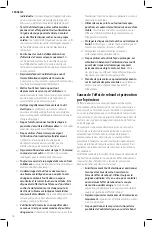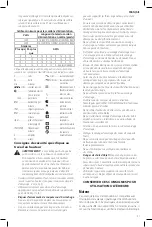
English
7
Intended Use
Your heavy-duty cut off tool has been designed for
professional grinding, sanding, wire brush, and cut-off
applications at various work sites (i.e., construction sites).
DO nOT
use under wet conditions or in presence of
flammable liquids or gases.
Your heavy-duty cut off tool is a professional power tool.
DO nOT
let children come into contact with the tool.
Supervision is required when inexperienced operators use
this tool.
Features
Lanyard Connection (Fig. B)
WARNING:
To reduce the risk of injury, user must
read lanyard instructions before use. Do not use near
moving parts, mechanisms or running machinery.
The lanyard connection
14
is intended for use by
competent personnel, who are trained and knowledgeable
regarding working with tools in and around machinery and
"at height".
14
Fig. B
The lanyard connection is for attaching appropriate lanyards
for use at height, 6.5 ft (2 m) maximum length, rated for at
least 12.0 lbs (5.43 Kg) , with locking carabiner ends. Refer
to Figure B.
WARNING:
Do not use rope or cord and do not attach
by looping or knotting. Only attach tool to a lanyard
with a locking carabiner.
WARNING:
If the tool is dropped for any reason the
lanyard connection must be inspected and properly
serviced prior to re-use. The lanyard connection is
designed to stretch to absorb the shock of a drop. Any
permanent stretch to the connection exposing the red
internal coils indicates it has been compromised and
must be serviced prior to reuse.
E-switch Protection™
The ON/OFF trigger switch has a no-volt release function.
In the event of a power outage or other unexpected shut
down, the switch will need to be released if still being held
on and then re-engaged to restart tool.
E-Clutch™
This unit is equipped with an E-Clutch™ (Electronic Clutch),
which in the event of a high-load or wheel pinch, the unit
will be shut off to reduce the reaction torque to the user.
The switch will need to be released if still being held on and
then re-engaged to restart tool.
Power-OFF™ Overload Protection
The power supply to the motor will be reduced in case of
motor overload. With continued motor overload, the tool
will shut off. The switch will need to be released if still being
held on and then re-engaged to restart tool. The tool will
power off each time the current load reaches the overload
current value (motor burn-up point). If continued overload
shutdowns occur, apply less force/weight on the tool until
the tool will function without the overload engaging.
Electronic Soft Start
This feature limits the initial start up momentum, allowing
the speed to build up gradually over a 1 second period.
ASSEMBLY AND ADJUSTMENTS
WARNING: To reduce the risk of serious personal
injury, turn unit off and disconnect it from
power source before making any adjustments or
removing/installing attachments or accessories.
An accidental start-up can cause injury.
Attaching Side Handle (Fig. A)
WARNING:
Before using the tool, check that the
handle is tightened securely.
CAUTION:
Only use the adjustable cut-off guard with
the side handle in the left side of the gear case.
Screw the side handle
5
tightly into the hole on the left
side of the gear case. The side handle should always be used
to maintain control of the tool at all times.
Guards
CAUTION: Guards must be used with all grinding
wheels, cutting wheels, sanding flap discs,
wire brushes, and wire wheels.
The tool may
be used without a guard only when sanding with
conventional sanding discs. Refer to Figure A to see
guards provided with the unit. Some applications may
require purchasing the correct guard from your local
dealer or authorized service center.
nOTE:
Edge grinding and cutting can be performed with
Type 27 wheels designed and specified for this purpose;
6.35 mm thick wheels are designed for surface grinding
while thinner Type 27 wheels need to be examined for
the manufacturer's label to see if they can be used for
surface grinding or only edge grinding/cutting. A Type 1
guard must be used for any wheel where surface grinding
is forbidden. Cutting can also be performed by using a
Type 41 wheel and a Type 1 guard.
nOTE:
See the
Accessories Chart
to select the proper
guard/accessory combination.
Adjusting and Mounting
Guard (Fig. C, D)
CAUTION:
Turn unit off and unplug the tool before
making any adjustments or removing or installing
attachments or accessories.
CAUTION:
BEFORE operating the tool, identify which
guard adjustment option your tool is set to.
Adjustment Options
For guard adjustment, the guard release lever
15
engages
one of the alignment holes
13
on the guard collar using










































